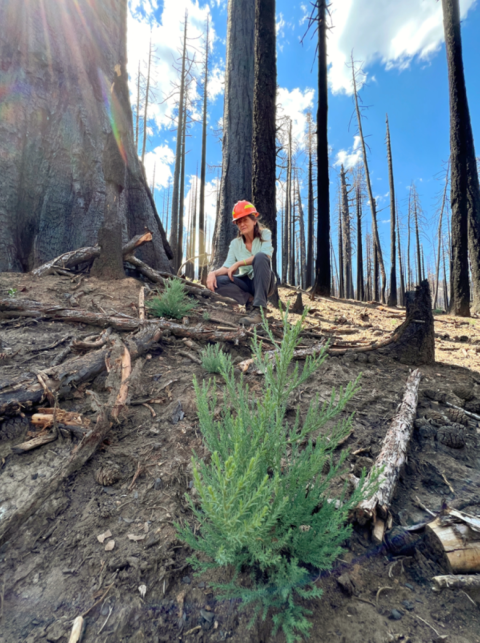In 2023, the U.S. Fish and Wildlife Service proposed to add the California spotted owl to the list of species protected by the Endangered Species Act. The proposal noted wildfire as the leading threat to the bird, and thankfully, efforts are already underway to improve the health of California’s forests, reduce the threat of wildfire and conserve habitat in the Sierra Nevada for dozens of species.
California spotted owls need forests that have varying tree heights, pine and leafy trees, and a mix of open and densely forested areas for nesting, foraging, and roosting.
“Large-scale, high severity wildfires have negatively impacted the owl’s habitat and mountain communities alike,” said Mike Fris, field supervisor of the U.S. Fish and Wildlife Service’s Sacramento Fish and Wildlife Office.
Since 2020, more than 1.7 million acres of forestland in the Sierra Nevada have burned in wildfires. Some fires have burned through the owl’s preferred habitat type at such high intensity that there aren’t enough healthy trees left behind to serve as a seed source for natural forest restoration. In some places, these fires are changing the landscape in the Sierra Nevada from forested areas to shrubland.
“Protecting habitat for the California spotted owl is important, but it’s part of a bigger picture. Reducing the risk of high-severity, large scale wildfire in our forests is important for maintaining biodiversity in our state, providing clean air and water to the people who live here, generating resources that support the economy, and conserving open spaces for recreation,” said Fris.
Most of the land inhabited by California spotted owls is managed by the U.S. Forest Service, Sierra Pacific Industries and the Bureau of Land Management. Over the past few years, the Service has worked alongside their biologists and leadership to inform or develop plans that balance the needs of wildlife with forest management, forest fuels reduction and timber harvesting. Through these efforts, land managers have processes in place for identifying key locations that are being actively used by the California spotted owl and methods for completing work without disrupting key life stages, such as the mating season or when adults are caring for young.
“We are grateful for our partners who are working diligently to reduce the risk of large-scale high-severity wildfire across the state. It can’t be done by just one entity. By working together, we can create healthier forests that support people, communities and nature in balance,” said Fris.
Currently, the Service is analyzing data submitted through the public comment process on the proposal to list the California spotted owl and aims to make a final decision in 2024. Whether or not the bird is placed on the list of threatened and endangered species, the plans will continue and play a role in protecting California’s forests.
“We believe the work that is already underway will be important for reducing the risk of large scale, high-severity wildfire across California’s Sierra Nevada. Climate change will continue to impact our forests, and we need to do what we can to reduce the impacts to our residents and wildlife,” said Fris.
Conservation at Work
U.S. Forest Service Conservation Strategy for California Spotted Owls in the Sierra Nevada
In 2019, the U.S. Forest Service completed a California spotted owl conservation strategy for national forests spanning the Sierra Nevada. The conservation strategy aims to maintain a well-distributed and stable population of California spotted owls across forests of the Sierra Nevada. The strategy recommends retaining connected areas with key forest elements the owl selects for such as large, tall trees and forests stands with varying tree types and canopy heights. The strategy also contains methods for enhancing habitat resilience to fire, floods or other disturbances. These goals can be achieved while the USFS increases the pace and scale of forest restoration and forest fuels management while maintaining important habitat elements for California spotted owls.
Sierra Pacific Industries Habitat Conservation Plan
The Service works with many businesses to develop habitat conservation plans. These plans help balance the impacts of a proposed activity, such as developing a housing community or harvesting timber, with the needs of listed species in the area where the activity will take place. Sierra Pacific Industries worked with the Service to develop a habitat conservation plan (HCP) for its timber harvesting activities across the Sierra Nevada. As part of the HCP, Sierra Pacific Industries implements a variety of forest management activities to support California and northern spotted owls, including building strategic firebreaks to combat potential wildfires and establishing owl protection zones in areas where spotted owls are active or nesting. The HCP covers more than 1.5 million acres of Sierra Pacific Industries forestlands in Amador, Butte, Calaveras, El Dorado, Lassen, Modoc, Nevada, Placer, Plumas, Shasta, Sierra, Siskiyou, Tehama, Trinity, Tuolumne and Yuba counties.
Bureau of Land Management Forest Fuels Treatment Plan
In 2023, the Service and the Bureau of Land Management finalized a statewide plan that supports the BLM’s work to complete forest fuels management activities on 930,000 acres across 44 California counties. The Service provided recommendations to support the conservation of more than 100 species, including the California spotted owl, as BLM creates a network of strategic forest fuels treatments and breaks that aim to reduce the risk of major wildfires and improve the safety of communities bordering BLM lands. For the California spotted owl specifically, the plan includes measures to ensure that project activities do not negatively impact suitable habitat (e.g., maintain high canopy cover, maintain multilayered/multispecies overstory canopy, retain large mature trees and snags, and retain downed woody material). Additionally, a seasonal restriction for project activities will be implemented during the breeding and nesting season to protect the owls during this sensitive period. The removal of nest trees is prohibited and not covered under the plan.






